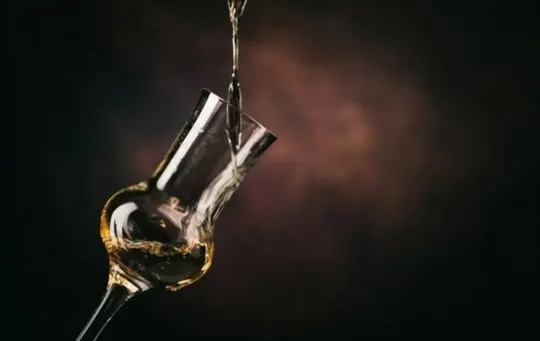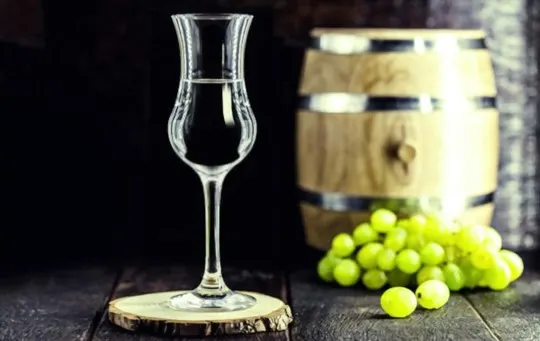Grappa – the fermented grape beverage from Italy – has perplexed and intrigued drinkers around the world.
There are a million questions, such as: What’s the difference between Grappa and other wines?
Is it sweet or dry? How do you mix it and what kind of food pairs with it?
If those questions have been keeping you up nights, we’ve got answers!
In this comprehensive guide, we’ll answer all your burning questions about Grappa so that you can finally get some restful sleep…and become a bona fide Grappa expert.
So read on to find out what makes Grappa unique, as well as our recommended ways to serve it to friends or enjoy its robust taste yourself!
What is Grappa?

Grappa is a spirit that comes from Italy, made using the grape skins, seeds, and stems leftover from the wine-making process.
When making Grappa, the grape matter is distilled in copper stills to create a clear liquid with an alcohol content of between 35-60%.
The name ‘Grappa’ comes from the Italian word ‘grappolo’, meaning grape cluster.
Grappa is a popular after-dinner drink traditionally enjoyed by Italians.
It’s often served in small glasses or shot glasses at room temperature or slightly chilled.
Though it hasn’t always had the best reputation for quality, recent years have seen Grappa’s reputation improve as producers focus on using better-quality grapes and refining their production methods.
Essentially, it’s a brandy made from grape leftovers that would otherwise be discarded during the winemaking process.
These pomace (grape residue) are fermented and then distilled to create a clear spirit that packs quite a punch.
Though traditionally considered an Italian beverage, other countries like Argentina and Uruguay also produce their version of this spirit.
What Does Grappa Taste Like?

Grappa is a clear brandy made from pomace, which is the grape pulp, skins, and stems that remain after wine production.
So, what does grappa taste like? Let’s find out.
Grappa has a strong and sharp taste.
It can be described as bitter and pungent, with intense flavors of grapes and herbs.
You might notice hints of wood or fruit depending on the aging process used to make the grappa.
Unlike wine, grappa is not sweet but it may have a slight sweetness in its finish.
The taste of grappa also depends on the type of grapes used to make it.
For example, if you use Moscato grapes to make grappa, it might have floral notes with an almost syrupy consistency.
On the other hand, if you use Cabernet Sauvignon grapes, you might get dark fruit flavors with earthy undertones.
The aging process also affects the taste of grappa.
Grappas that are aged for longer periods tend to have more complex flavors than young ones.
They could have hints of vanilla or spices due to extended contact with wood.
In general, drinking grappa can be an acquired taste due to its strong flavor profile.
Some people enjoy sipping it straight while others prefer mixing it into cocktails or using it in cooking.
Factors that Affect the Taste of Grappa
Grappa is a complex drink with various factors that influence its taste.
The first and most important factor is the type of grape used to make it.
Different grapes produce different flavors and aromas, ranging from fruity and floral to spicy and herbal.
As a consequence, each varietal provides its own unique set of characteristics to the final product.
Another key factor in determining the flavor of grappa is how it’s distilled.
Traditional pot stills are capable of producing more flavorful distillates, while their modern counterparts focus more on efficiency and yield.
This can result in a less complex product with less character.
The aging process also affects the final flavor profile of grappa.
Oak barrels are commonly used for aging spirits, but grappa can also be aged in cherry or acacia wood barrels for a subtle sweet or floral taste respectively.
The length of time spent aging greatly alters the taste, texture, and overall experience of drinking grappa.
Lastly, the alcohol content plays a role in determining how grappa tastes.
Most varieties hover around 40-45% ABV (alcohol by volume), but higher-proof options exist which bring out more potent flavors and intensify the overall sensation.
How to Drink Grappa?

Grappa, in Italian culture, is a symbol of tradition and familiarity.
The first thing to consider when drinking grappa is the serving temperature.
The ideal temperature for serving grappa is between 10-12°C (50-54°F).
A slightly chilled serving will allow you to taste the subtle nuances of flavor and aroma in the drink.
When it comes to choosing a glass for drinking grappa, one should opt for a tulip-shaped glass or even a wine glass rather than a shot glass.
The wider rim at the top allows for better flavor and aroma perception.
To enjoy your grappa fully, swirl the liquid around the glass gently before smelling it.
Take small sips and hold each one in your mouth before swallowing.
This technique helps to absorb all the flavors that grappa has to offer.
In terms of food pairing, cheese and cured meats go well with grappa due to their strong flavors.
Additionally, desserts such as chocolate cake or almond-based pastries make great accompaniments to this spirit.
Culinary Uses of Grappa
Grappa is not just a drink to be enjoyed after a meal; it can also be used in cooking.
One popular culinary use of grappa is in risotto, where it can add a unique flavor and aroma to the dish.
It can also be used in pasta sauces or as a marinade for meats.
When using grappa in cooking, it’s important to remember that it has a high alcohol content and should be added with caution.
Too much grappa can overpower the other flavors in a dish and make it too strong.
Another way to use grappa in cooking is by soaking fruits in it.
Grappa-soaked fruit can add an interesting twist to desserts such as cakes or tarts.
The alcohol will cook off during the baking process, leaving behind only the unique flavor of the grappa.
If you’re feeling adventurous, you can even try making your own liqueur using grappa.
Simply mix fresh berries or herbs with some grappa, sugar, and water, and let it steep for several days before straining out the solids.
Overall, there are many creative ways to incorporate grappa into your cooking repertoire.
Just remember to use it sparingly and experiment with different flavor combinations to discover what works best for you.
Where to Buy Grappa and How to Store It?

To find Grappa, visit liquor stores, specialty food stores or online and ask for suggestions from staff.
You can pick the one you prefer based on the brand or region of production.
As for storage, keep it in a cool, dry place away from direct sunlight to prevent any loss of taste or aroma.
When storing unopened bottles of grappa, it’s best to keep them upright and in a dark place at room temperature.
If you have already opened the bottle, particularly if half-full, make sure to reseal tightly to prevent oxidation that may change the flavor profile of your grappa.
Once open, experts say that the optimum period for consuming it is between three months to one year.
It’s good practice to buy only what you need since grappa does not get better with age once bottled.
It’s advisable to purchase fewer but higher-quality brands as their flavors are more distinct and appealing.
Conclusion
Grappa is a popular Italian liquor made from grape pomace, which is the leftover skins, stems, and seeds from winemaking.
It has a distinct flavor and aroma that can vary depending on the type of grape used, the distillation process, and the aging period.
If you are interested in trying grappa, there are many options for purchasing it both online and in-person.
You may be able to find it at specialty liquor stores or online retailers that specialize in imported spirits.
When storing grappa, it should be kept in a cool, dark place away from sunlight or heat sources.

What Does Grappa Taste Like? A Comprehensive Guide
Ingredients
- Grappa
- Ingredients from your selected recipes
Instructions
- Select ingredients that work well together.
- Use a recipe or method that will enhance their natural taste.
- Taste and adjust the recipe as needed to achieve the desired flavor.

Carrie is a food writer and editor with more than 15 years of experience. She has worked for some of the biggest names in the food industry, including Bon Appétit, Food & Wine, and Martha Stewart Living.
As the Editor in Chief of IntroChicago.com, Carrie oversees all of the content on the site. She also manages the team of contributing writers and editors, who help to create delicious recipes, helpful tips, and informative articles that you’ll find on the site.
A native of the Chicago area, Carrie is passionate about all things food. She loves trying new restaurants and experimenting with new recipes in her kitchen. She’s also a graduate of the Culinary Institute of America, so she knows a thing or two about food!
